Four-image NAVCAM mosaic comprising images taken on 10 September from a distance of 27.8 km from comet 67P/Churyumov-Gerasimenko (reminder: the distance is given to the centre of the comet). The image scale is approximately 2.5 metres per pixel.
The four individual frames are also provided below (for more information on this presentation of images see the earlier blog post: CometWatch Update).
We know that many of you like exploring these images, and one feature you may quickly notice is the rather bright object seen near the centre of the slope in the upper right. We too were curious and looked at an image taken earlier and it was not visible (the shadow beneath it is coincidence; this is also seen in images without the object). Therefore it is most likely either an image artefact or a transient object in the foreground.
Indeed, if you adjust the contrast of the image you will see that there is a lot of ‘noise’ in the background. Some of this is simply detector noise and cosmic rays, but there seem to be a few bright objects that may be dust/ice particles between Rosetta and the comet.
In previous NAVCAM and OSIRIS images, we’ve already seen jets of gas laced with dust streaming away from the comet, and the instruments COSIMA and GIADA have started detecting dust, so it would be no surprise if these objects were also found to originate from the comet. In any case, it is a phenomenon that will clearly be studied in great detail at 67P/C-G over the coming weeks and months.
Another nice observation you might like to make while playing around with the contrast settings is that faint details can be brought out in the ‘neck’ region of 67P/C-G, which on first look is seemingly obscured by shadows. It appears as though the neck is being illuminated by the reflection of sunlight off the main body of the comet below.

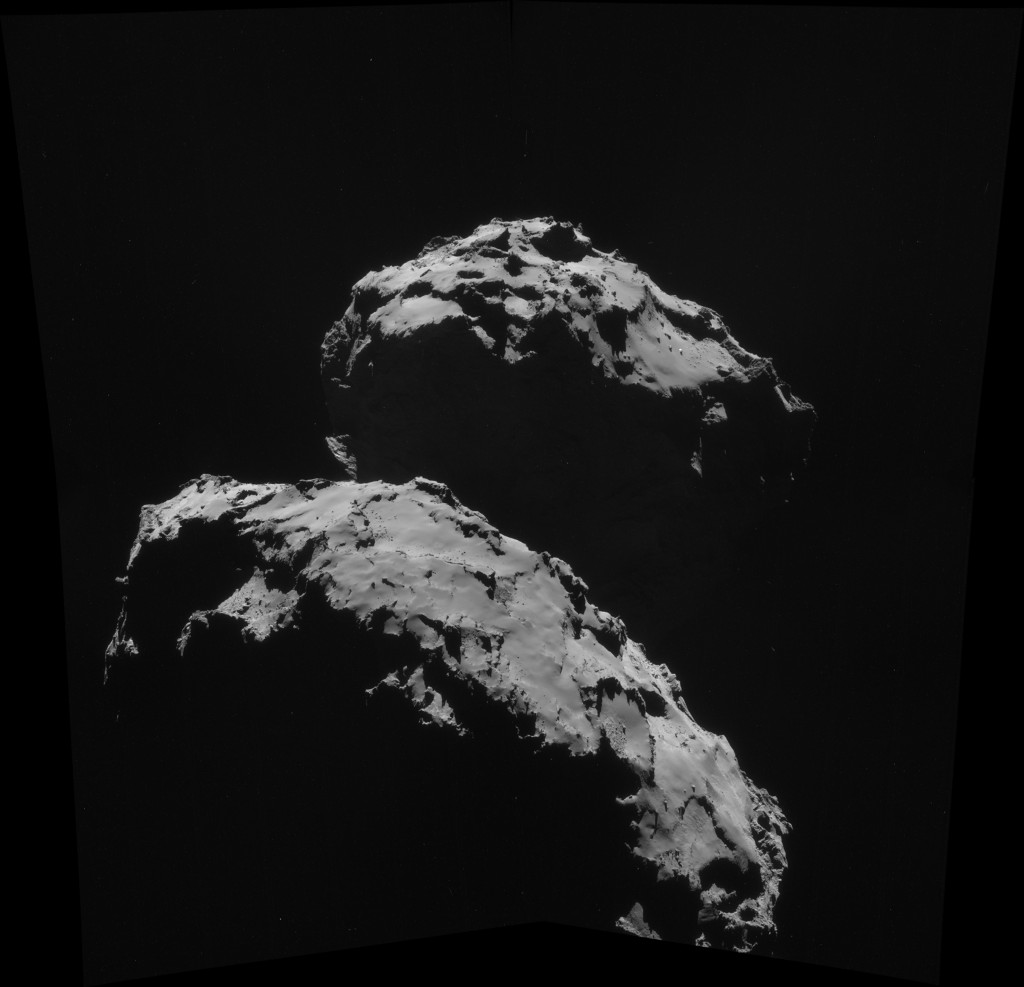
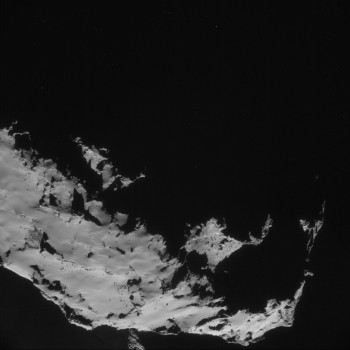
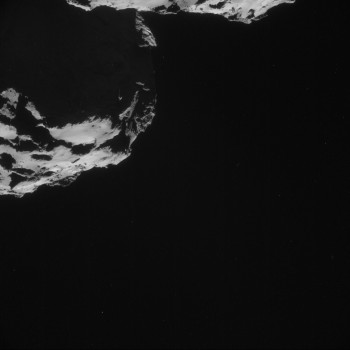
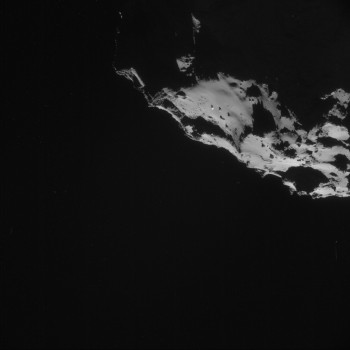
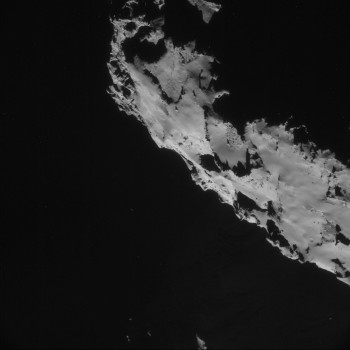








Discussion: 26 comments
This old voyager.
Are we going to listen to her?
Imagine should be watching crystals by now:
https://giantcrystals.strahlen.org/america/naica.htm
Interesting transient feature.
Recall that Comet Hartley2 was surrounded by a veritable blizzard of ice particles from 3cm to 30 cm in size.
https://www.nasa.gov/mission_pages/epoxi/images/pia13625.html
https://www.jpl.nasa.gov/images/epoxi/20101118/pia13624-4×3.jpg
I would hope that P67P will be as active as Comet Hartley was.
–Bill
If you read it again you will find the description fluffy snowballs thats far from ice, O K ?
“It appears as though the neck is being illuminated by the reflection of sunlight off the main body of the comet below. (?)
Can sunlight be reflected off a body whose albedo, by all accounts, is even lower than that of charcoal?
I actually don’t see any neck illumination. It is caught in the shadow of the body.
Image processing is the keyword.
Its used to show as much as possible in one picture.
But you must reprocess its information in your head to grasp the reality. To do this you need experience and if this is not present you will be miss lead.
I rewatched the arrival conference video. https://wpc.50e6.edgecastcdn.net/8050E6/mmedia-http/download/public/videos/2014/08/010/1408_010_AR_EN.mp4
When they approached the comet and was testing out VIRTIS, they detected that the minimum mean temperature of the comet seems to be coming from the neck. We must then ask, why? We have seen images of direct sunlight, and it was getting direct sunlight at the time of the measurement. The max temperature came from a section on the “Body”, the mid temp was on the “head”, and minimum on the neck. The areas void of volatiles and are pores are the locations with the max temp. Does this mean there is either more volatiles and the area is less pores at the neck?
The Sep 2 image did show out gassing at the neck, which would seem to make sense if there were more volatiles there.
We also saw jets at the plains area on the underside of the “body”. Im interested in measurements there, and at the large plains area on the crown of the “head” as seen in my comparison. It would seem due to the smoothness that there has been activity there.
Now, since they did post the VIRTIS map on the 8th. It does show that the top of the “head” which is A site landing target is very cool, so is the area around the neck, as well as the bottom of the “body” as very cool. The large plains on the body which Bill and I had recently conducted comparisons is also the other cool location.
https://celestialimaging.blogspot.com/2014/09/67pc-g-comparing-shadows-and-angles.html
These three locations seem to show the evidence of activity geologically. While these areas would be great landing sites terrain wise, they are areas of cold conditions. The only one of these where a landing was considered was “A”, which may have lost out due to the revelation of the temperature. The landing sites seem to be in areas other then these active locations, which for a success of the mission, would make sense, though the question stands, will there be any data regarding the outgassing if you are not in an area not as active? Come November perhaps those sides of the body will be more active. But, as they are the hot areas, it would show that not only is it porous there, but either low or no volatiles. Which goes to show, IF there are volatiles at the dark regions, what do they composed of? We wont get this answer unless we are there to drill and find out.
Possible Landing Site “A” on the crown of the “head”
https://celestialimaging.blogspot.com/2014/09/comet-67pc-g-has-ridge-gone-missing.html
There is no not transparent material i know of that has zero reflection when illuminated. Per this definition some light will be reflected. The best light absorbing device i know is a Laser Target that still reflects about 0.1% in the visual range, thats 30 times less then the comet and if illuminated with a 10 mW green laser it is obvious that it reflects light.
Every object can reflect sunlight, unless it is a perfect black body, or a black hole. Look at asphalt on a sunny day, it is bright enough that you’d want to wear sunglasses.
Is it possible to also include in these blog entries the estimated angle of the sun to the comet? Would be great to be able to use to allow calculations of crater wall depth measurements, and other object height.
Updated the animation sequence from Aug 5 – Sep 11
https://celestialimaging.blogspot.com/p/comet-watch.html
But, another curiosity is what appears to be some sort of ridge or surface discoloration in the Aug 17 image seems to be gone in the Sep 10 image. The “ridge” stretches from the first boulder and lines up with the other two boulders. I originally thought that what we are seeing is a side angle of a long mound and the darkness is the long shadow. But looking on the Sep 10, there does not seem to be a mound or discolored strip on the surface.
I have reoriented the Sep 10 to match the image from Aug 17.
https://celestialimaging.blogspot.com/2014/09/comet-67pc-g-has-ridge-gone-missing.html
Any thoughts on what this might be from? Am I seeing things, or missing something?
I wonder if this could perhaps be evidence of some sort of linear vent? The area along the line in the Aug 17 images appears rougher and more stones seems to be along the discoloration. Yet, when we see it again in the Sep 10 image, the area seems to be a lot more smoother, perhaps the smaller stones/boulders having been covered by the dust? Though, is there enough of a centripetal force for dust to settle?
Very interesting observation Errol. Maybe regolith is gaining volume by subduing gas infiltration. Need other ideas on this photo comparative.
Could it be just jpeg artifacts, but there seems to be some kind of ‘weaving’ on the dust before witnessing changes on surface signals.
Once you get a general grasp of the pattern of the boulders from the Aug 17 image, you can see a little displacing of the boulders on Sep 10, plus despite the graininess, the ground does seem rougher in the first image verses the new, If dust after impacts on the moon can settle, what would prevent the dust from the vents from settling, covering up the discoloration after the vent ceased?
Difference to moon here is micro-gravity and humidity. I would expect some kind of minimal ‘cementing’ that would give the vent wall some postmortem presence, as it happens at the ‘craters’ borders. Accepting your model if the gas here is ‘dry’. But, how could it be?
I have not come back to the only published 3D Osiris image (‘Only’ is how I’ll call it). But at some point seems to suggest a ‘plateau’. If a ‘plateau’ is what we have at the bottom of areas like this, then it is ‘incoming weather’ the dominant agent of change. Then those are little impact craters and not vents. Then many other things like dry and ionized gas, etc.
On the ‘cheerio’. What about a softly landing ‘snow puff’? ‘Snow puff’ has been mentioned before on coma composition.
Emily, is the Sep 2 image the only day captured showing vents? Would be very interesting, and help capture more public attention to release more.
It remains spectacualr to be able to witness all this. I am looking forward to try to get a glimpse from the comet from earth in a couple of months.
Do you have access to a 30 inch diameter telescope!?
Erroll–
I’ll look at the 17Aug-10Sept sequence. Initially it looks like a couple of jumbled areas I’m especially on the watch for changes in the comet…
–Bill
Yep, I know you have been doing some comparative. There seems to be alot of change there, either by the loss of the darker area perhaps from vent activity, then covered up by settling dust, and the notable O shape cheerio object on the lower left of the right image that looks like a pit for a yet. The shadowing woul indicate just a stone ans the round shadow in the middle would indicate a depression with rounded edges. Looks like a rounded mound with a vent exit.
Fantastic images as ever. In reference to the ‘imaging artifact / transient object’… could it possibly be a glint of light coming from any facetting on the boulder it superimposes? I doubt it personally and I only mention it because of the near perfect alignment. It would be ‘uber-cool’ to start seeing activity akin to Hartley2 but only if it poses no extra risk to our daring, darling Rosetta.
¿sure? It’s very weak
Update 2 – Sep 12
After further research,
https://3.bp.blogspot.com/-u9NT2l6s5FY/VBPLTbJq8GI/AAAAAAAAO_s/PrSC8pCsJkA/s1600/Ridge%2Bat%2BArrival.jpg
The line/discoloration is visible on the arrival images as showing during the arrival webcast. To orientate you, he image compared to the above images are upside down.The O cheerio structure is now seen at the upper right of the image now.
It is not until Sep 10 image that the strip is no longer visible. Speculating recent vent activity.